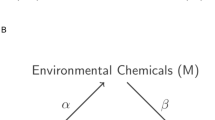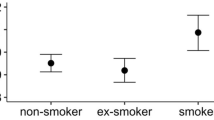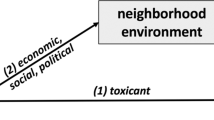Abstract
Exposure to VOCs is linked to health effects ranging from asthma to cancer and to negative impacts on the hematopoietic system. We examined the association between select blood VOC concentrations and hematological measures in a representative sample of the U.S. population from NHANES cycles spanning the years 2005 to 2010. We used Cox regression to assess the association between complete blood count with five-part differential (CBC) parameters and seven select blood VOCs, while addressing low detection rates among VOCs. Tobacco smoke exposure was classified using serum cotinine levels. The not-smoke-exposed group had lower VOC levels for most analytes compared with the smoke-exposed. Correlations between benzene, toluene, ethylbenzene, and xylenes (BTEX) were moderate to strong. Statistical associations were found between benzene, toluene, ethylbenzene, xylene, and styrene (BTEXS) and hematocrit, hemoglobin, and white blood cell count among the smoke-exposed. Among the not-smoke-exposed, there was an association between BTEX and platelet count. We considered benzene most likely to be associated with higher levels of CBC concentrations. Our findings suggest VOC levels currently found in the general U.S. population are associated with changes in hematological measures, and smoking could be a contributor.
This is a preview of subscription content, access via your institution
Access options
Subscribe to this journal
Receive 6 print issues and online access
$259.00 per year
only $43.17 per issue
Buy this article
- Purchase on Springer Link
- Instant access to full article PDF
Prices may be subject to local taxes which are calculated during checkout


Similar content being viewed by others
References
Technical overview of volatile organic compounds. 2017. https://www.epa.gov/indoor-air-quality-iaq/technical-overview-volatile-organic-compounds.
Volatile organic compounds’ impact on indoor air quality. 2017. https://www.epa.gov/indoor-air-quality-iaq/volatile-organic-compounds-impact-indoor-air-quality.
Arif AA, Shah SM. Association between personal exposure to volatile organic compounds and asthma among US adult population. Int Arch Occup Environ Health. 2007;80:711–9.
Su F-C, Mukherjee B, Batterman S. Trends of VOC exposures among a nationally representative sample: Analysis of the NHANES 1988 through 2004 data sets. Atmos Environ. 2011;45:4858–67.
Jain RB. Detection rates, trends in and factors affecting observed levels of selected volatile organic compounds in blood among US adolescents and adults. Environ Toxicol Pharm. 2017;56:21–28.
Klepeis NE, Nelson WC, Ott WR, Robinson JP, Tsang AM, Switzer P, et al. The National Human Activity Pattern Survey (NHAPS): a resource for assessing exposure to environmental pollutants. J Expo Anal Environ Epidemiol. 2001;11:231–52.
García-Esquinas E, Jiménez A, Pastor-Barriuso R, Jones MR, Perez-Gomez B, Navas-Acien A, et al. Impact of declining exposure to secondhand tobacco smoke in public places to decreasing smoking-related cancer mortality in the US population. Environ Int. 2018;117:260–7.
Jeng HA, Lee IL, Gau YY, Yang CT, Lin C, Hong YJ. Changes in immunological and hematological parameters of female residents exposed to volatile organic compounds in the city of Kaohsiung, Taiwan. J Environ Health. 2006;69:20–25.
Doherty BT, Kwok RK, Curry MD, Ekenga C, Chambers D, Sandler DP, et al. Associations between blood BTEXS concentrations and hematologic parameters among adult residents of the U.S. Gulf States. Environ Res. 2017;156:579–87.
Bolden AL, Kwiatkowski CF, Colborn T. New look at BTEX: are ambient levels a problem? Environ Sci Technol. 2015;49:5261–76.
Humans; IWGotEoCRt. Chemical agents and related occupations. Vol 100F. Lyon, France: International Agency for Research on Cancer; 2012.
Koh DH, Jeon HK, Lee SG, Ryu HW. The relationship between low-level benzene exposure and blood cell counts in Korean workers. Occup Environ Med. 2015;72:421–7.
Pelallo-Martinez NA, Batres-Esquivel L, Carrizales-Yanez L, Diaz-Barriga FM. Genotoxic and hematological effects in children exposed to a chemical mixture in a petrochemical area in Mexico. Arch Environ Contam Toxicol. 2014;67:1–8.
D’Andrea MA, Reddy GK. Benzene exposure from the BP refinery flaring incident alters hematological and hepatic functions among smoking subjects. Int J Occup Med Environ Health. 2017;30:849–60.
National Center for Health Statistics Survey methods and analytic guidelines. Atlanta, GA: Centers for Disease Control and Prevention, National Center for Health Statistics; 2008.
Johnson CL, Paulose-Ram R, Ogden CL, Carroll MD, Kruszon-Moran D, Dohrmann SM, et al. National health and nutrition examination survey: analytic guidelines, 1999-2010. Vital- Health Stat. 2013;2:1–24.
National Center for Health Statistics. NHANES 2009–2010 Labratory Methods. 2009. https://wwwn.cdc.gov/nchs/nhanes/ContinuousNhanes/LabMethods.aspx?.
National Center for Health Statistics. National Health and Nutrition Examination Survey; 2009–2010 Data Documentation, Codebook, and Frequencies; Volatile Organic Compounds (VOCs)-Blood (VOCWB_G). National Center for Health Statistics. https://wwwn.cdc.gov/Nchs/Nhanes/2009-2010/VOC_F.htm.
Blount BC, Kobelski RJ, McElprang DO, et al. Quantification of 31 volatile organic compounds in whole blood using solid-phase microextraction and gas chromatography-mass spectrometry. J Chromatogr B Anal Technol Biomed Life Sci. 2006;832:292–301.
Kim S. Overview of cotinine cutoff values for smoking status classification. Int J Environ Res Public Health. 2016;13:1236.
Hornung RW, Reed LD. Estimation of average concentration in the presence of nondetectable values. Appl Occup Environ Hyg. 1990;5:46–51.
Dinse GE, Jusko TA, Ho LA, Annam K, Graubard BI, Hertz-Picciotto I, et al. Accommodating measurements below a limit of detection: a novel application of Cox regression. Am J Epidemiol. 2014;179:1018–24.
Gillespie BW, Chen Q, Reichert H, Franzblau A, Hedgeman E, Lepkowski J, et al. Estimating population distributions when some data are below a limit of detection by using a reverse Kaplan-Meier estimator. Epidemiology. 2010;21:S64–S70.
Chambers DM, Ocariz JM, McGuirk MF, Blount BC. Impact of cigarette smoking on volatile organic compound (VOC) blood levels in the U.S. population: NHANES 2003–2004. Environ Int. 2011;37:1321–8.
Perez-Stable EJ, Marin BV, Marin G, Brody DJ, Benowitz NL. Apparent underreporting of cigarette consumption among Mexican American smokers. Am J Public Health. 1990;80:1057–61.
Canada H. Third report on human biomonitoring of environmental chemicals in Canada. Ottawa, Ontario: Government of Canada; 2017.
Casale T, Sacco C, Ricci S, Loreti B, Pacchiarotti A, Cupelli V, et al. Workers exposed to low levels of benzene present in urban air: Assessment of peripheral blood count variations. Chemosphere. 2016;152:392–8.
Tulinska J, Dusinska M, Jahnova E, Liskova A, Kuricova M, Vodicka P, et al. Changes in cellular immunity among workers occupationally exposed to styrene in a plastics lamination plant. Am J Ind Med. 2000;38:576–83.
Akbas E, Derici E, Soylemez F, Kanik A, Polat F. An investigation of effects of toluene and cigarette smoking on some blood parameters and lymphocyte life span. Cell Biol Toxicol. 2004;20:33–40.
Malenica M, Prnjavorac B, Bego T, Dujic T, Semiz S, Skrbo S, et al. Effect of cigarette smoking on haematological parameters in healthy population. Med Arch. 2017;71:132–6.
Snyder R. Recent developments in the understanding of benzene toxicity and leukemogenesis. Drug Chem Toxicol. 2000;23:13–25.
Krishnan RM, Sullivan JH, Carlsten C, Wilkerson HW, Beyer RP, Bammler T, et al. A randomized cross-over study of inhalation of diesel exhaust, hematological indices, and endothelial markers in humans. Part Fibre Toxicol. 2013;10:7.
Girdhar G, Xu S, Bluestein D, Jesty J. Reduced-nicotine cigarettes increase platelet activation in smokers in vivo: a dilemma in harm reduction. Nicotine Tob Res. 2008;10:1737–44.
Robert Schnatter A, Kerzic PJ, Zhou Y, Chen M, Nicolich MJ, Lavelle K, et al. Peripheral blood effects in benzene-exposed workers. Chem Biol Interact. 2010;184:174–81.
Uzma N, Salar BM, Kumar BS, Aziz N, David MA, Reddy VD. Impact of organic solvents and environmental pollutants on the physiological function in petrol filling workers. Int J Environ Res Public Health. 2008;5:139–46.
Rubinstein ML, Delucchi K, Benowitz NL, Ramo DE. Adolescent exposure to toxic volatile organic chemicals from E-cigarettes. Pediatrics. 2018;141.
Churchill JE, Ashley DL, Kaye WE. Recent chemical exposures and blood volatile organic compound levels in a large population-based sample. Arch Environ Health: Int J. 2001;56:157–66.
Lin YS, Egeghy PP, Rappaport SM. Relationships between levels of volatile organic compounds in air and blood from the general population. J Expo Sci Environ Epidemiol. 2008;18:421–9.
Agency for Toxic Substances and Disease Registry. Toxicological profile for Benzene. Atlanta, GA: U.S. Department of Health and Human Services PHS; 2007.
Acknowledgements
The authors would like to acknowledge the contributions of CDC Division of Laboratory Science, the Tobacco and Volatiles branch.
Funding
The findings and conclusions in this report are those of the authors and do not necessarily represent the official positions of the Centers for Disease Control and Prevention. Use of trade names and commercial sources is for identification only and does not constitute endorsement by the U.S. Department of Health and Human Services, or the U.S. Centers for Disease Control and Prevention.
Author information
Authors and Affiliations
Corresponding author
Ethics declarations
Conflict of interest
The authors declare that they have no conflict of interest.
Additional information
Publisher’s note Springer Nature remains neutral with regard to jurisdictional claims in published maps and institutional affiliations.
Rights and permissions
About this article
Cite this article
Vaughan Watson, C., Naik, S., Lewin, M. et al. Associations between select blood VOCs and hematological measures in NHANES 2005–2010. J Expo Sci Environ Epidemiol 31, 366–376 (2021). https://doi.org/10.1038/s41370-019-0192-8
Received:
Revised:
Accepted:
Published:
Issue Date:
DOI: https://doi.org/10.1038/s41370-019-0192-8
Keywords
This article is cited by
-
Association of volatile organic compound exposure with metabolic syndrome and its components: a nationwide cross-sectional study
BMC Public Health (2024)
-
Low-dose blood BTEX are associated with pulmonary function through changes in inflammatory markers among US adults: NHANES 2007–2012
Environmental Science and Pollution Research (2023)
-
Exposures to volatile organic compounds, serum vitamin D, and kidney function: association and interaction assessment in the US adult population
Environmental Science and Pollution Research (2023)
-
Association of lifestyle behaviors with health-related quality of life among patients with hematologic diseases
Quality of Life Research (2023)
-
Association between serum cotinine and volatile organic compounds (VOCs) in adults living with HIV, HBV, or HCV (NHANES 2005–2018)
Scientific Reports (2022)



